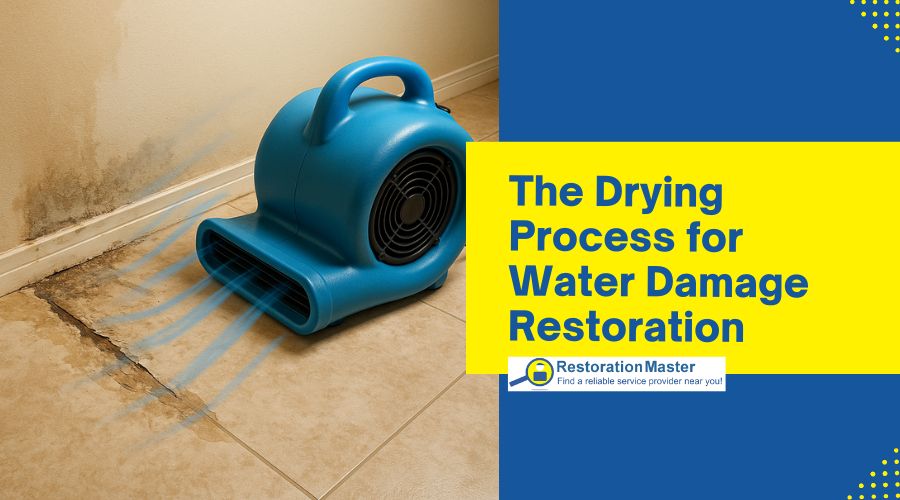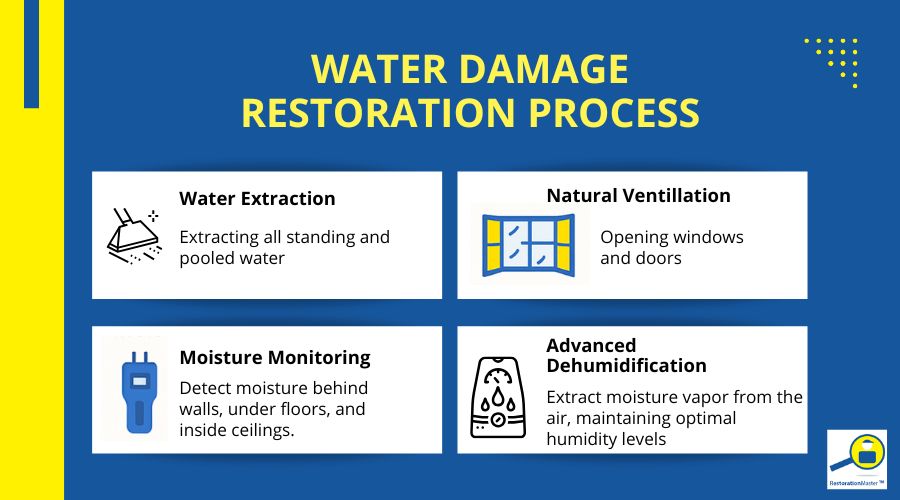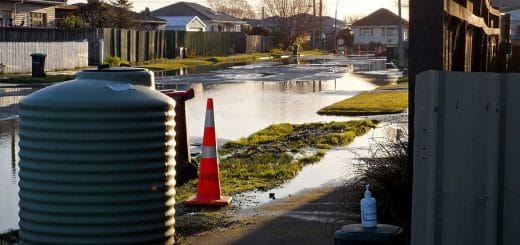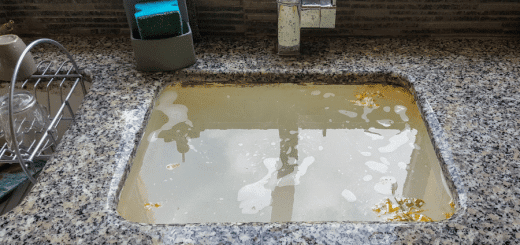The Drying Process for Water Damage Restoration: In-Depth Guide to Safeguarding Your Property

Summary: Discover the 7-step professional dryingDrying is the process of removing moisture from materials, s... More process used to restore water-damaged properties—fast, effective, and designed to prevent long-term issues. From powerful extraction to precision moisture monitoringMonitoring is the ongoing observation and measurement of con... More, every step is key.
Water damage is one of the most urgent threats to the integrity and safety of any property. It can result from natural disasters like floodingFlooding is the overflow or accumulation of water in areas t... More, sudden incidents such as burst pipes, or long-term issues like leaks and high indoor humidityHumidity is the amount of moisture or water vapor present in... More. The process of dryingDrying is the process of removing moisture from materials, s... More and restoring your home or business after water damage is critical—not only to repairRepair is the act of fixing or restoring damaged property, m... More visible damage but to prevent hidden, long-term problems that can compromise structural soundness and human health.
This comprehensive guide dives deep into the scientific principles, advanced methodologies, and best practices of water damage dryingDrying is the process of removing moisture from materials, s... More, empowering you with the knowledge to act decisively and understand why professional intervention is indispensable.
Understanding Water Damage: The Invisible Threat Beyond What Meets the Eye
Water damage is often underestimated because much of its impact happens beneath surfaces. When water infiltrates your home, it seeps into porousPorous describes a material that contains small openings or ... More materials such as drywall, insulationInsulation is a material used in buildings to reduce the tra... More, wood framing, flooring, and upholstery. These materials absorb water and retain moisture for extended periods if not properly dried.
Hidden moisture leads to serious consequences:
- Structural Degradation: Water weakens wood by causing swelling, warpingWarping is the bending, twisting, or distortion of materials... More, and ultimately rot, jeopardizing the load-bearing capacity of beams, studs, and flooring. Drywall can lose its integrity, crumble, or delaminate.
- Health Hazards: Persistent moisture fosters the growth of moldMold is a type of fungus that grows in damp or humid conditi... More, mildewMildew is a type of fungus that grows on damp surfaces, typi... More, bacteria, and other pathogensPathogens are microorganisms such as bacteria, viruses, or f... More. MoldMold is a type of fungus that grows in damp or humid conditi... More sporesSpores are microscopic reproductive units of fungi or mold t... More are microscopic and airborne, posing respiratory risks, triggering allergies, and potentially leading to serious illnesses.
- Electrical and Fire Hazards: Water contact with electrical wiring, outlets, and appliances can cause short circuits, increasing the risk of fire and electrocution.
- Economic Loss: Untreated water damage can escalate repairRepair is the act of fixing or restoring damaged property, m... More costs exponentially, reduce property value, and complicate insurance claims.
Because of these risks, effective dryingDrying is the process of removing moisture from materials, s... More must target all affected materials—both visible and hidden—and halt the progression of moisture-related damage.
The Critical Importance of Immediate and Effective Drying
Time is the most important factor in water damage restorationWater damage restoration is the professional process of clea... More. Scientific research and industry standards (IICRC S500) underscore that moldMold is a type of fungus that grows in damp or humid conditi... More growth can begin within 24 to 48 hours of water exposure. Delaying dryingDrying is the process of removing moisture from materials, s... More gives moldMold is a type of fungus that grows in damp or humid conditi... More sporesSpores are microscopic reproductive units of fungi or mold t... More the opportunity to colonize surfaces and materials, making remediation far more complicated and expensive.
Early drying delivers multiple benefits:
- Limits the spread and penetration of moisture into building materials.
- Prevents microbial colonization, reducing health risks and odorAn odor is a smell, often detectable by the human nose, whic... More problems.
- Reduces overall damage severity, thereby lowering repairRepair is the act of fixing or restoring damaged property, m... More and replacement costs.
- Simplifies insurance claims by showing timely, documented mitigation efforts.
- Improves restorationRestoration is the process of returning a property to its pr... More timelines, allowing occupants to return to normal sooner.
The Science of Drying: Balancing Airflow, Temperature, and Humidity
Water damage dryingDrying is the process of removing moisture from materials, s... More is fundamentally a moisture management process involving evaporationEvaporation is the process by which a liquid, such as water,... More, air movement, and moisture removal.
- EvaporationEvaporation is the process by which a liquid, such as water,... More: Moisture held in wet materials changes from liquid form into water vaporVapor is the gaseous form of a substance that is typically l... More. This phase change is driven by temperature and humidityHumidity is the amount of moisture or water vapor present in... More differentials between the wet material and surrounding air.
- Airflow: Moving air removes the moisture-laden vaporVapor is the gaseous form of a substance that is typically l... More away from the wet surface, preventing saturationSaturation is the point at which a material or environment c... More of the air immediately above it and allowing evaporationEvaporation is the process by which a liquid, such as water,... More to continue. Proper air circulation is key to speeding up dryingDrying is the process of removing moisture from materials, s... More.
- DehumidificationDehumidification is the process of reducing and controlling ... More: As evaporationEvaporation is the process by which a liquid, such as water,... More increases humidityHumidity is the amount of moisture or water vapor present in... More in the air, moisture removal devices (dehumidifiers) extract water vaporVapor is the gaseous form of a substance that is typically l... More to maintain a low relative humidityRelative humidity (RH) is the percentage of moisture in the ... More. Without dehumidificationDehumidification is the process of reducing and controlling ... More, high humidityHumidity is the amount of moisture or water vapor present in... More slows evaporationEvaporation is the process by which a liquid, such as water,... More and prolongs dryingDrying is the process of removing moisture from materials, s... More.
Optimizing these three elements requires balancing heat (warmer air accelerates evaporationEvaporation is the process by which a liquid, such as water,... More), airflow patterns, and humidityHumidity is the amount of moisture or water vapor present in... More control—a process that restorationRestoration is the process of returning a property to its pr... More professionals carefully engineer.

Step-by-Step Breakdown of the Modern Water Damage Drying Process
Step 1: Thorough Water Extraction
Extracting all standing and pooled water is the foundational step. Industrial-grade equipment is used:
- Submersible PumpsSubmersible pumps are electric pumps designed to operate und... More: For large volumes of water, pumps remove water quickly from basements, crawl spaces, and flood zones.
- Truck-Mounted and Portable Extractors: These powerful vacuum systems remove water embedded in carpets, padding, and flooring layers. They can extract water far more effectively than manual methods.
- Wet/Dry Shop Vacs: Specialized for smaller amounts of water and tight spaces, but not a substitute for professional extractors.
Immediate water removal prevents saturationSaturation is the point at which a material or environment c... More and limits damage to structural materials.
Step 2: Controlled Natural Ventilation (When Feasible)
Opening windows and doors can encourage natural airflow if outdoor conditions are dry and temperature-controlled. This passive method is only effective in certain climates and is rarely sufficient for serious water damage.
Step 3: Mechanical Air Movement
Specialized air movers and axial fans are deployed strategically to push air at high velocity over wet surfaces. These devices:
- Increase evaporationEvaporation is the process by which a liquid, such as water,... More rates by replacing moist air near wet materials with drier air.
- Are moisture-resistant and designed to operate in damp environments without risk of damage or short circuits.
- Target hard-to-reach areas such as wall cavities, under cabinets, and beneath flooring layers.
- This step requires expertise in positioning and equipment selection to ensure even dryingDrying is the process of removing moisture from materials, s... More and prevent moisture pockets.
Step 4: Advanced Dehumidification
As evaporationEvaporation is the process by which a liquid, such as water,... More occurs, the air’s moisture contentMoisture content is the amount of water present in a materia... More rises, potentially reaching saturationSaturation is the point at which a material or environment c... More and halting further dryingDrying is the process of removing moisture from materials, s... More. Industrial dehumidifiers are used to:
- Extract moisture vaporVapor is the gaseous form of a substance that is typically l... More from the air, maintaining optimal humidityHumidity is the amount of moisture or water vapor present in... More levels (typically 30-50% relative humidityRelative humidity (RH) is the percentage of moisture in the ... More).
- Utilize two main technologies:
-
-
Refrigerant Dehumidifiers: Cool air to condense moisture; effective in moderate temperature ranges.
-
Desiccant Dehumidifiers: Use moisture-absorbing materials for very low temperatures or high humidityHumidity is the amount of moisture or water vapor present in... More environments.
-
Continuous dehumidificationDehumidification is the process of reducing and controlling ... More keeps dryingDrying is the process of removing moisture from materials, s... More efficient and protects against condensation on cold surfaces.
Step 5: Continuous Moisture Monitoring
RestorationRestoration is the process of returning a property to its pr... More experts employ sophisticated tools to track dryingDrying is the process of removing moisture from materials, s... More progress:
- Pin and Pinless Moisture Meters: Measure moisture contentMoisture content is the amount of water present in a materia... More in wood, drywall, and concrete without destroying materials.
- Thermal Imaging Cameras: Detect moisture behind walls, under floors, and inside ceilings by identifying temperature differences caused by water.
- Hygrometers: Monitor air temperature and relative humidityRelative humidity (RH) is the percentage of moisture in the ... More to maintain ideal dryingDrying is the process of removing moisture from materials, s... More conditions.
Ongoing data collection allows technicians to adjust dryingDrying is the process of removing moisture from materials, s... More equipment in real-time and verify when affected materials have returned to safe moisture levels.
Step 6: Removal or Treatment of Saturated Materials
PorousPorous describes a material that contains small openings or ... More materials like drywall, insulationInsulation is a material used in buildings to reduce the tra... More, carpets, and upholstered furniture often absorb water beyond the point of effective dryingDrying is the process of removing moisture from materials, s... More and require removal to prevent moldMold is a type of fungus that grows in damp or humid conditi... More growth. Non-porous surfaces such as tile, concrete, and metal can usually be dried and sanitized.
RestorationRestoration is the process of returning a property to its pr... More teams assess each material’s salvageability based on water contaminationContamination is the presence of harmful or unwanted substan... More levels (clean, gray, or black water) and extent of saturationSaturation is the point at which a material or environment c... More.
Step 7: Use of Desiccants and Specialized Drying Techniques
For items sensitive to airflow or enclosed spaces where air movement is limited, desiccants such as silica gel, calcium chloride, or clay compounds absorb moisture over time. These materials are sealed in airtight containers with the wet item and monitored until dryness is achieved.
Additionally, advanced methods like injectidry systems deliver heated air directly into wall cavities or floorboards to accelerate dryingDrying is the process of removing moisture from materials, s... More in concealed areas.
For a deeper look at the dryingDrying is the process of removing moisture from materials, s... More timeline, read our guide: How Long Does It Take to Dry Out Water Damage?
Cutting-Edge Technologies Revolutionizing Water Damage Restoration
Since earlier restorationRestoration is the process of returning a property to its pr... More methods, the industry has incorporated innovative tools and approaches that improve dryingDrying is the process of removing moisture from materials, s... More effectiveness and accuracy:
- Thermal and Infrared Imaging: Pinpoint hidden moisture without invasive demolition, preserving property while ensuring thorough dryingDrying is the process of removing moisture from materials, s... More.
- Remote Moisture Sensors: Allow continuous, real-time monitoringMonitoring is the ongoing observation and measurement of con... More of dryingDrying is the process of removing moisture from materials, s... More progress from offsite locations.
- HEPA Air Scrubbers: Trap moldMold is a type of fungus that grows in damp or humid conditi... More sporesSpores are microscopic reproductive units of fungi or mold t... More and airborne contaminants released during dryingDrying is the process of removing moisture from materials, s... More, safeguarding indoor air qualityIndoor air quality (IAQ) refers to the condition of the air ... More.
- Data-Driven DryingDrying is the process of removing moisture from materials, s... More Plans: Software analyzes moisture data to optimize dryingDrying is the process of removing moisture from materials, s... More equipment settings, reducing downtime and cost.
- Environmentally Friendly Biocides and Cleaning Agents: Used during remediation to eliminate bacteria and fungiFungi are a group of organisms, including mold, mildew, and ... More without harsh chemical residues.
These technologies not only speed restorationRestoration is the process of returning a property to its pr... More but improve occupant safety and long-term outcomes.
Immediate Actions You Can Take Before Professionals Arrive
While waiting for restorationRestoration is the process of returning a property to its pr... More experts, consider the following measures to reduce damage:
- Stop the water source if safe to do so (turn off main water valve).
- Move valuables and electronics away from affected areas.
- Avoid walking on wet carpets or floors to prevent tracking contaminants.
- Open windows and doors only if outdoor conditions are dry and warm.
- Avoid using HVAC systems unless inspected, to prevent spreading contaminants.
- Use portable fans or dehumidifiers if you have them and it is safe.
- Remove soaked rugs and cushions and dry them outdoors if possible.
Remember, avoid electrical appliances or outlets near water and never use household vacuums to extract water.
The Indispensable Role of Professional Water Damage Restoration Services
Certified restoration companies bring unparalleled benefits:
- Expertise: Technicians trained and certified by IICRC and other industry bodies understand water categories (clean, gray, black water) and appropriate responses.
- Equipment: Industrial-grade pumps, extractors, air movers, and dehumidifiers far outperform consumer-grade options.
- Safety: Proper handling of contaminants, biohazards, and moldMold is a type of fungus that grows in damp or humid conditi... More.
- Comprehensive restorationRestoration is the process of returning a property to its pr... More: From dryingDrying is the process of removing moisture from materials, s... More to structural repairs, sanitization, deodorization, and finishing.
- Insurance assistance: Professional documentation simplifies claims.
- Long-term protection: Recommendations for moisture control and moldMold is a type of fungus that grows in damp or humid conditi... More preventionPrevention refers to actions taken to reduce the likelihood ... More post-restoration.
DIY efforts rarely match the thoroughness or safety provided by pros and often result in recurring problems.
Mold Prevention and Sustained Indoor Environmental Quality
Proper dryingDrying is the process of removing moisture from materials, s... More alone isn’t always enough to prevent moldMold is a type of fungus that grows in damp or humid conditi... More. RestorationRestoration is the process of returning a property to its pr... More specialists typically:
- Apply antimicrobial and antifungal treatments to vulnerable surfaces.
- Clean and disinfect HVAC systems to prevent moldMold is a type of fungus that grows in damp or humid conditi... More sporesSpores are microscopic reproductive units of fungi or mold t... More spreading through ventilationVentilation is the process of exchanging or circulating air ... More.
- Use air scrubbers and filters to capture airborne sporesSpores are microscopic reproductive units of fungi or mold t... More during and after restorationRestoration is the process of returning a property to its pr... More.
- Provide homeowners with guidance on controlling humidityHumidity is the amount of moisture or water vapor present in... More, ventilationVentilation is the process of exchanging or circulating air ... More, and detecting signs of moisture intrusion early.
Don’t wait—call a trusted water damage restoration professional today to stop the damage and start the recovery.
Frequently Asked Questions
What are the signs that something hasn't dried properly?
Incomplete dryingDrying is the process of removing moisture from materials, s... More is a common issue in DIY restorationRestoration is the process of returning a property to its pr... More and can leadLead is a heavy metal that can be toxic to humans, especiall... More to hidden moldMold is a type of fungus that grows in damp or humid conditi... More growth, structural deterioration, or air quality problems. Warning signs include:
- Persistent musty or earthy odors
- Discoloration or staining on walls, ceilings, or floors
- Peeling paint or wallpaper
- WarpingWarping is the bending, twisting, or distortion of materials... More or buckling of wood or flooring
- Visible moldMold is a type of fungus that grows in damp or humid conditi... More growth in corners or behind furniture
- Condensation on windows or cold surfaces
Professionals confirm dryness with moisture meters and thermal cameras—visual inspectionInspection is the careful examination and assessment of a pr... More alone is not reliable.
Is it necessary to remove baseboards, drywall, or flooring to dry everything?
Often, yes—especially if water has wicked up the walls or seeped beneath flooring. Here’s why:
- Baseboards and trimTrim is the decorative or functional molding used to finish ... More can trap moisture behind walls.
- Drywall acts like a spongeA sponge is a porous material used to absorb liquids or clea... More, and moisture can rise well above the visible damage line.
- Underlayment and subflooring can retain hidden moisture even after surface layers appear dry.
Professional restorationRestoration is the process of returning a property to its pr... More companies use controlled demolition (removing only what’s necessary) to expose saturated materials and apply direct dryingDrying is the process of removing moisture from materials, s... More.
Will my insurance cover the cost of drying and restoration?
In many cases, yes—but it depends on your policy and the cause of damage:
- Most homeowner’s insuranceHomeowner’s insurance is a policy that provides financial ... More covers sudden and accidental water damage, like burst pipes or appliance failures.
- FloodingFlooding is the overflow or accumulation of water in areas t... More from natural disasters usually requires separate flood insurance.
- Insurers typically require proof of timely action, such as calling a restorationRestoration is the process of returning a property to its pr... More company and preventing further damage.
nbsp;












